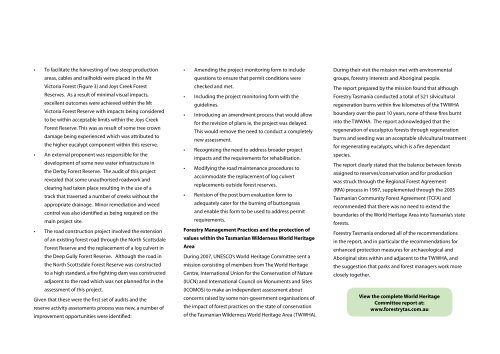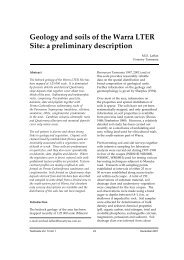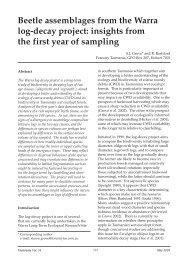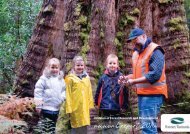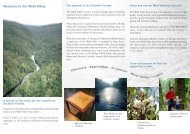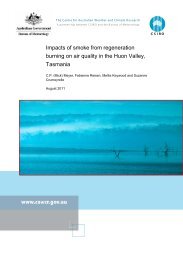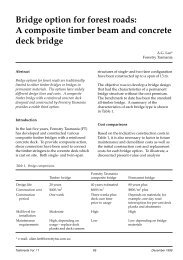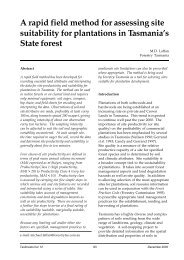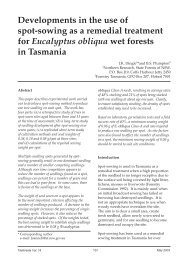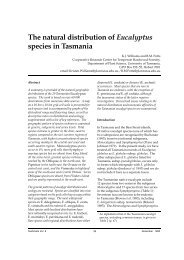sustainable forest management - Forestry Tasmania
sustainable forest management - Forestry Tasmania
sustainable forest management - Forestry Tasmania
You also want an ePaper? Increase the reach of your titles
YUMPU automatically turns print PDFs into web optimized ePapers that Google loves.
•<br />
•<br />
•<br />
To facilitate the harvesting of two steep production<br />
areas, cables and tailholds were placed in the Mt<br />
Victoria Forest (Figure 3) and Joys Creek Forest<br />
Reserves. As a result of minimal visual impacts,<br />
excellent outcomes were achieved within the Mt<br />
Victoria Forest Reserve with impacts being considered<br />
to be within acceptable limits within the Joys Creek<br />
Forest Reserve. This was as result of some tree crown<br />
damage being experienced which was attributed to<br />
the higher eucalypt component within this reserve.<br />
An external proponent was responsible for the<br />
development of some new water infrastructure in<br />
the Derby Forest Reserve. The audit of this project<br />
revealed that some unauthorised roadwork and<br />
clearing had taken place resulting in the use of a<br />
track that traversed a number of creeks without the<br />
appropriate drainage. Minor remediation and weed<br />
control was also identified as being required on the<br />
main project site.<br />
The road construction project involved the extension<br />
of an existing <strong>forest</strong> road through the North Scottsdale<br />
Forest Reserve and the replacement of a log culvert in<br />
the Deep Gully Forest Reserve. Although the road in<br />
the North Scottsdale Forest Reserve was constructed<br />
to a high standard, a fire fighting dam was constructed<br />
adjacent to the road which was not planned for in the<br />
assessment of this project.<br />
Given that these were the first set of audits and the<br />
reserve activity assessments process was new, a number of<br />
improvement opportunities were identified:<br />
•<br />
•<br />
•<br />
•<br />
•<br />
•<br />
Amending the project monitoring form to include<br />
questions to ensure that permit conditions were<br />
checked and met.<br />
Including the project monitoring form with the<br />
guidelines.<br />
Introducing an amendment process that would allow<br />
for the revision of plans ie, the project was delayed.<br />
This would remove the need to conduct a completely<br />
new assessment.<br />
Recognising the need to address broader project<br />
impacts and the requirements for rehabilitation.<br />
Modifying the road maintenance procedures to<br />
accommodate the replacement of log culvert<br />
replacements outside <strong>forest</strong> reserves.<br />
Revision of the post burn evaluation form to<br />
adequately cater for the burning of buttongrass<br />
and enable this form to be used to address permit<br />
requirements.<br />
<strong>Forestry</strong> Management Practices and the protection of<br />
values within the <strong>Tasmania</strong>n Wilderness World Heritage<br />
Area<br />
During 2007, UNESCO’s World Heritage Committee sent a<br />
mission consisting of members from The World Heritage<br />
Centre, International Union for the Conservation of Nature<br />
(IUCN) and International Council on Monuments and Sites<br />
(ICOMOS) to make an independent assessment about<br />
concerns raised by some non-government organisations of<br />
the impact of <strong>forest</strong> practices on the state of conservation<br />
of the <strong>Tasmania</strong>n Wilderness World Heritage Area (TWWHA).<br />
During their visit the mission met with environmental<br />
groups, <strong>forest</strong>ry interests and Aboriginal people.<br />
The report prepared by the mission found that although<br />
<strong>Forestry</strong> <strong>Tasmania</strong> conducted a total of 521 silvicultural<br />
regeneration burns within five kilometres of the TWWHA<br />
boundary over the past 10 years, none of these fires burnt<br />
into the TWWHA. The report acknowledged that the<br />
regeneration of eucalyptus <strong>forest</strong>s through regeneration<br />
burns and seeding was an acceptable silvicultural treatment<br />
for regenerating eucalypts, which is a fire dependant<br />
species.<br />
The report clearly stated that the balance between <strong>forest</strong>s<br />
assigned to reserves/conservation and for production<br />
was struck through the Regional Forest Agreement<br />
(RFA) process in 1997, supplemented through the 2005<br />
<strong>Tasmania</strong>n Community Forest Agreement (TCFA) and<br />
recommended that there was no need to extend the<br />
boundaries of the World Heritage Area into <strong>Tasmania</strong>’s state<br />
<strong>forest</strong>s.<br />
<strong>Forestry</strong> <strong>Tasmania</strong> endorsed all of the recommendations<br />
in the report, and in particular the recommendations for<br />
enhanced protection measures for archaeological and<br />
Aboriginal sites within and adjacent to the TWWHA, and<br />
the suggestion that parks and <strong>forest</strong> managers work more<br />
closely together.<br />
View the complete World Heritage<br />
Committee report at:<br />
www.<strong>forest</strong>rytas.com.au


